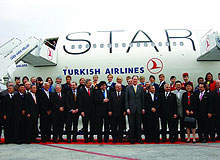
Turkish Airlines (THY) has seen passengers and profits soar as a result of its aggressive policy of opening ten new destinations every year to pick up transit passengers travelling through its Istanbul hub at Atatürk Airport.
“We used to receive 10 million passengers per year; now we have 31 million,” says Temel Kotil. “And on top of this, we have quadrupled our revenues.”

Discover B2B Marketing That Performs
Combine business intelligence and editorial excellence to reach engaged professionals across 36 leading media platforms.
THY’s analysis is that the airline business’s centre of gravity is shifting from North America and Europe towards the Far East.
“In Europe there are a lot of small cities with limited passenger catchment areas. So throughout Europe, they need to go to hub cities to reach their destinations. In order to capture the transit through Turkey along the air highway, which passes over Turkey to the Far East, Middle East and North Africa, we have developed a network that has made it feasible for passengers to make timely transits in Istanbul.”
With a fleet of 127 aircraft and a programme to add a further 105 in the next 13 years, THY is defying the downturn that has hit many other carriers and is now second only to Ryanair in terms of being the world’s most profitable carrier. “We have roughly 5,000 flights per week on 124 international routes as well as 37 domestic routes. If you take all those routes, then THY is ranked ninth largest in terms of coverage. However, if you look at our flights per week, we are about the 25th largest. This means that we either have less frequency or we have more destinations than we are supposed to.
“We are doing this on purpose. When you open new routes, it brings synergy on the transit business. Because our cost structures are favourable and we have the financial muscle, we are able to subsidise the new routes until they become profitable. 12 months on those former new routes will be subsidising the latest new routes.”

US Tariffs are shifting - will you react or anticipate?
Don’t let policy changes catch you off guard. Stay proactive with real-time data and expert analysis.
By GlobalDataKotil says that THY has only ever abandoned one route when 15 years ago a link between Ankara and a regional French airport was dropped. Besides Europe, where there are 68 airports including a new four-daily slot at Heathrow, THY now collects from, among other countries, Kazakhstan, Kyrgyzstan, Tajikistan, Turkmenistan, Uzbekistan, Iran, Syria and Iraq. In Africa, it has 17 destinations including, most recently, Entebbe, Accra and Alexandria, with plans to add more.
An eighth Russian airport is shortly due along with Basra in Iraq and Shiraz in Iran. In North America, THY is adding Washington DC and Los Angeles to its New York, Chicago and Toronto services, and is now also running to Sao Paulo. In the Far East, there are currently nine destinations, which will shortly be joined by Hoshimi as a third Japanese airport.
The slimming option
As Kotil explains, THY is now using narrow-bodied aircraft to collect for the Atlantic and Far East.
“The majority of our fleet is medium-haul. Our business plan is to collect passengers from the healthy European market, which we are reaching with narrow-bodied aircraft. These are very good on short hops compared with larger planes. The trip cost is much lower but the unit cost is very favourable. It is a paradox. A bigger aircraft has a better unit cost structure because it is more efficient, but if you use large aircraft on short hops they become expensive because they were not designed for that purpose.”
Kotil maintains that narrow bodies come in at more than half the trip cost of a large aircraft on the same runs and THY also achieves better load factors.
“Of course narrow-bodied aircraft have drawbacks because they are smaller and not as comfortable as longhaul aircraft. So, the next logical step will be to turn our narrow bodies into nice, comfortable, even luxurious aircraft. It is not difficult. This is why the 65 narrow bodies that we are going to start receiving will have 45-inch business-class seats, which is not full-flat but still offers an excellent sleep. The traditional narrow-bodied business seat is 35 inches. We also have IAC system video on demand.”
A touch of luxury
THY is also looking into onboard telephony for its business class passengers. But how has THY managed to buck the downward trend on business class passengers?
“There are two schools of thoughts in the airline business, the first of which says that price is very important and the other that quality counts for more. I believe that the first holds true for the US and Europe, but the second is what matters in the Asian market. Turkey is in between them so we combine a very low-cost structure in the business- and economy-class services with high quality.
“Our unit cost in 2009 was €5.1 cents per seat kilometre, which is comparable with the European low-cost companies, whereas legacy carriers in Europe have about twice this rate. Therefore, we are able to attract business travellers as well as economy passengers.” Kotil’s greatest fear is that some governments may be tempted to protect struggling legacy carriers, not least because the centre of gravity is moving towards the Far East.
He says that THY’s robust performance, even with a growth in air travel, means that other carriers are losing market share. “We want an Open Skies policy because we believe that all passengers belong to an international network, not any one carrier.”





